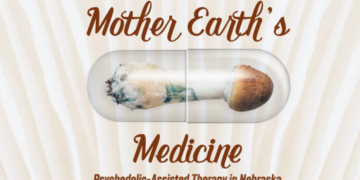Benson has seen an entrepreneur-led evolution in its century-plus history, continuing today with visionaries like BFF Omaha Executive Director Alex Jochim. He’s witnessed Benson transform from ghost town to destination magnet to Omaha’s creative pulse.
Founded by namesake Erastus Benson, the Benson neighborhood began as a suburban sanctuary before being annexed by Omaha and emerging around its own bustling Maple Street business center. By the late 1960s, Benson was an inner city enclave with modest single-family homes and a thriving business hub dominated by family-owned stores.
By the ’80s, however, many storefronts sat vacant or rundown. Benson has since reemerged as a vibrant center of commerce and in-demand place to live thanks to entrepreneurs who’ve opened speciality shops, bars and restaurants, and entertainment and art venues. Helping foster the burgeoning creative scene was Jochim, a photographer, who with artist JD Hardy, launched the Benson First Friday Art Walk in 2012.
The event’s popularity begat more art walks and programs until BFF organized as a nonprofit that sponsors year-round, offbeat programming.
“We like to keep things weird, avant-garde and nontraditional,” Jochim said. “And we like to have fun.”
By the time it rebranded as BFF Omaha in 2019, Benson’s renewal was in full swing.
“Before BFF, everything was pretty sterile, and we’re the opposite of that,” he continued. “We created this sense of community not only for creatives but for Benson overall. In the 12 years I’ve been there, I’ve seen a lot of development. The good thing is that it’s mainly owned and operated by people who invest in the community. It allows for less gentrification and more sense of community. That is what drew me to Benson and what’s keeping me here.
"We use BFF Omaha as a tool to create community and to support artists/creatives with new opportunities. It’s created this very broad mission of what we do, so we can tailor it to whatever creative endeavor we feel is our next move—as long as it’s supporting the arts and artists and community, it falls within our realm.”
John-Paul Gurnett first intersected with BFF while working as a public school teacher. He’s gone from a patron to creating events that plug into BFF, to becoming its communications director.
“BFF has continued to grow and evolve to meet the needs of our community, which legitimizes the work of so many who share their time, energy, and money,” Gurnett noted. “It has allowed me to draw upon all my areas of expertise in a creative way that benefits the place I call home.”
Professional development is part of how BFF invests in people,” Jochim added. “I love seeing people develop skills and being there as a teacher or guide to help them learn some of these processes.”
When Jochim moved to Benson around 2009, he discovered a neighborhood in transition.
“It wasn’t necessarily visually arts-focused,” he recalled. “[Though] there were a lot of musicians.”
He “got caught up” in making things happen on the visual arts front.
“I formed relationships through that,” he said. “Then those groups of people helped spark the idea to start the First Friday Art Walks. Once we started that it created this whole sense of a creative community that I didn’t even know existed in Omaha.”
Shelby Audiss has been with BFF in various roles since the start and now serves on its executive board.
“I’m a lifer. This organization is so special to me because of the people involved,” she said, crediting much of BFF’s success to Jochim. “The word ‘impossible’ does not exist in his lexicon. He has a knack for taking a creative vision, drumming up support, and making it happen. He’s instilled this sense of limitless possibility, acceptance, and support of everyone.”
“We canvassed the neighborhood, talked about the vision, got a lot of people on board,” Jochim recalled of the premiere art walk. “People asked what we were doing next. It was a sense of, okay, we’ve got to keep this going. Besides, we enjoyed it. We did a lot of pop-up shows in vacant spaces. It necessitated us remaining involved.”
BFF took on physical event spaces, Petshop and Sweatshop, and now supports four galleries.
Once established, Jochim said, “Traditions formed and we started getting more and more community involvement and partnerships.” New creative spaces have emerged in 402 Arts Collective, Maple Street Construct, and Benson Theatre.
“We partnered with nonprofits and businesses to do stuff together and to form one common vision. We had the artists and the energy, and those organizations had the resources.”
Ted and Wally’s and Jake’s Cigars, where Jochim tended bar for many years, are
longtime partners.
The New American Arts Festival—which highlights the creativity and cultures of area refugee and immigrant communities—celebrates 10 years this August. BFF’s largest fundraiser, the Petfest Music Festival, is set to feature local and regional artists on August 19.
Additionally, the final big First Friday of the season on September 1 turns into ‘Furst Friday’ and features dog-friendly activities.
Outside of Benson, BFF partners with Lincoln Calling and the Omaha Summer Arts Festival. Its converted semi-truck mobile MAMO Gallery makes the trip to Maha Music Festival, the annual Earth Day celebration, and other events.
“We’re not limited to Benson,” Jochim noted. “Public art is a great way we can get out. We did a big social justice mural project on Farnam Hill. We installed artist-designed billboards throughout rural Nebraska advocating for abortion access services. We believe in using art as a catalyst for change.”
Still, taking on a greater volume of projects and events comes with its share of growing pains.
“We’ve had our ups and downs, burnout moments, and doubts about making this sustainable. That’s actually why we became a nonprofit,” Jochim explained. “We needed a direction to go with it. It couldn’t be grassroots anymore.”
A small core staff and around 45 dedicated volunteers keep BFF firing on all cylinders.
“We’re here as a backbone consultant to businesses and organizations that want to get involved. We talk with them about best practices,” Jochim said. “We work with people about getting creative with their spaces. It doesn’t need to be a white wall gallery to showcase art or a creative element. It can even be window displays. It can be digital media. It can be having a performer out in front of your business.”
All of it, he said, “provides more opportunities for emerging artists and, I feel we’ve had a big impact on that front.”
“I feel like we’re still growing our roots and getting our foundation. It’s taken us a while to crack that foundation code for funding,” Jochim continued, noting his transition to working BFF full time. “Before, I didn’t have the capacity to dedicate what this organization needed.”
Now that state legislation has designated Benson a creative district, he’s involved in shaping its future.
“Once we hire someone to run that, I feel like it’s going to be unstoppable because the creative district (a Nebraska Arts Council administered program) allows access to more funding from the state,” Jochim said. “You can do infrastructure changes and large-scale projects. That’s what’s going to keep Benson growing and to allow BFF, which has been kind of managing that, to step out and pursue our vision of spreading to other communities."
While the additional funding is exciting and certainly appreciated by Jochim, it’s the people BFF supports, and now employs, that keeps him coming back.
“I love actually being with people—having conversations, and working with artists in nontraditional settings, poking at their creativity, and having them see it from different perspectives and angles. I love the installation process. That is what keeps me fueled. The other thing that keeps me going is my team.”
Visit bffomaha.org for more information.

This article originally appeared in the July/August 2023 issue of Omaha Magazine. To subscribe, click here.

Photo by Bill Sitzmann.











